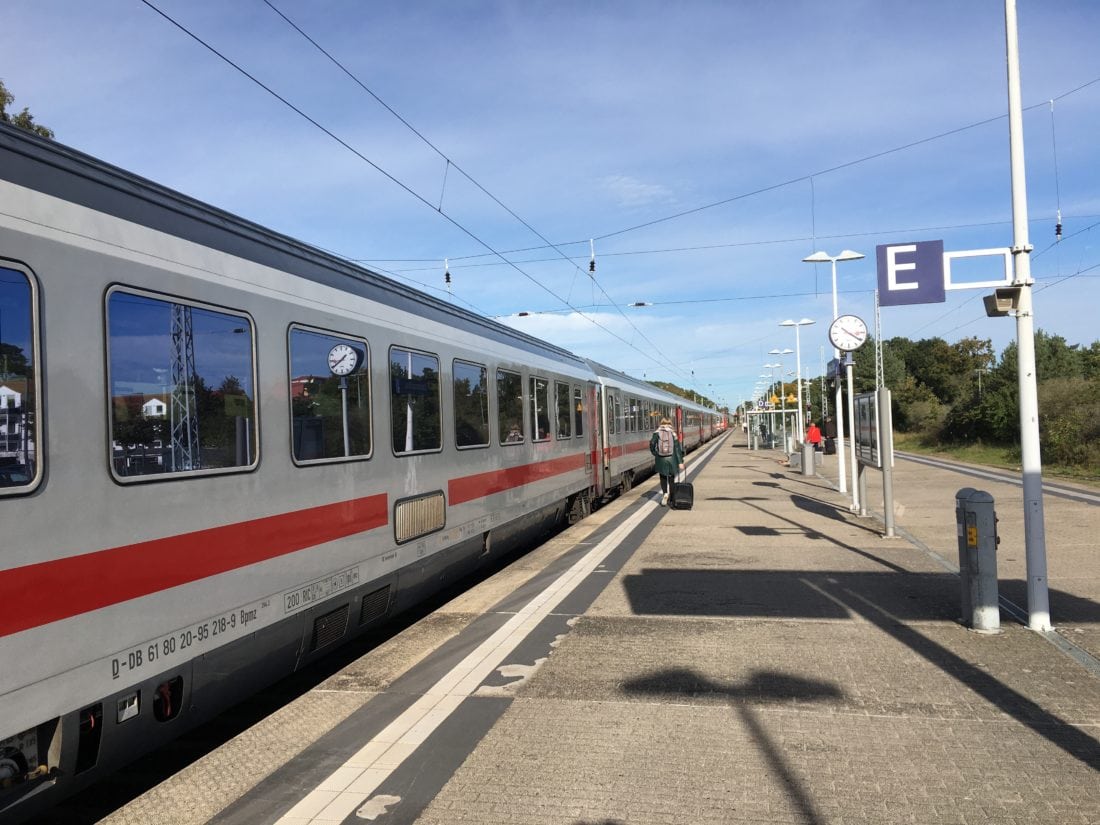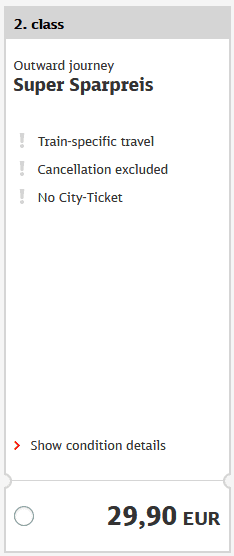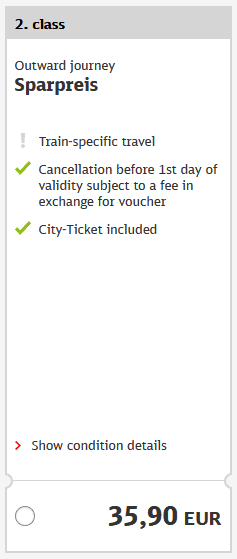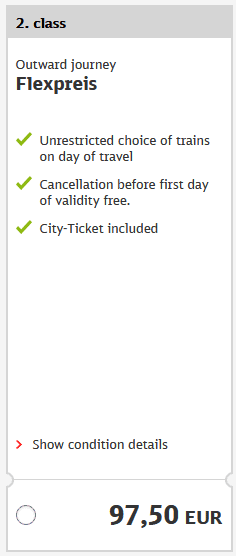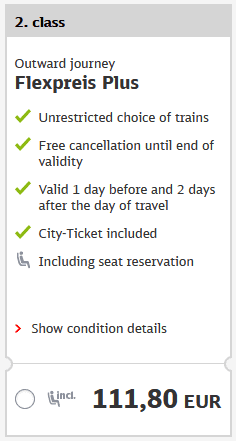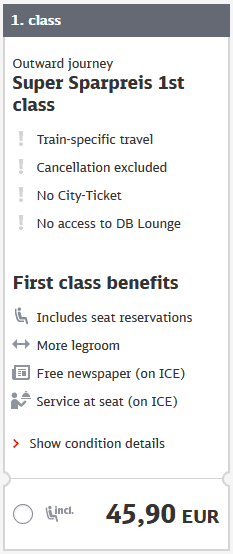Not only is Germany the most populous country in Europe, it is also located at the very heart of the continent. Bordering a total of nine other countries, almost any trip through Western Europe that doesn’t involve air travel makes it hard to avoid Deutschland. And why would you? It is the land of sausages, beer, salted pastry, and combining nouns to incomprehensible lengths.
One of the best ways to travel around the country is the railway. Germany is covered by more than 38,000 km of train tracks, allowing you to get from the biggest cities to the tiniest villages within hours. Germany’s national rail company Deutsche Bahn is not only one of the country’s largest employers, but also a national laughingstock for being wildly unreliable (by German standards, nonetheless) and their pricing not exactly easy to navigate.
If you are set on exploring the wonderful landmass between the North Sea, Baltic Sea, and the Alps in a train wagon, we gladly provide you with this guide to navigate your way.
Table of contents
Train Types
In general, you can differentiate between three train types when studying a German rail schedule. Long-distance, regional, and FlixTrains.
Long-Distance Trains
A long-distance train gets you from Hamburg to Bremen nonstop, in a comfy chair.
There are three types of long-distance trains in Germany: EuroCity (EC), InterCity (IC) and InterCity Express (ICE). The ICE is currently the pinnacle of German trains as it is the fastest and most comfortable train in Germany. It only stops in larger cities and important sites like large international airports or trade fairs. The same goes for EC and IC, though they are usually not as quick and comfy as the ICE. Unlike most European countries, German long distance trains don’t have automatically assigned seating.
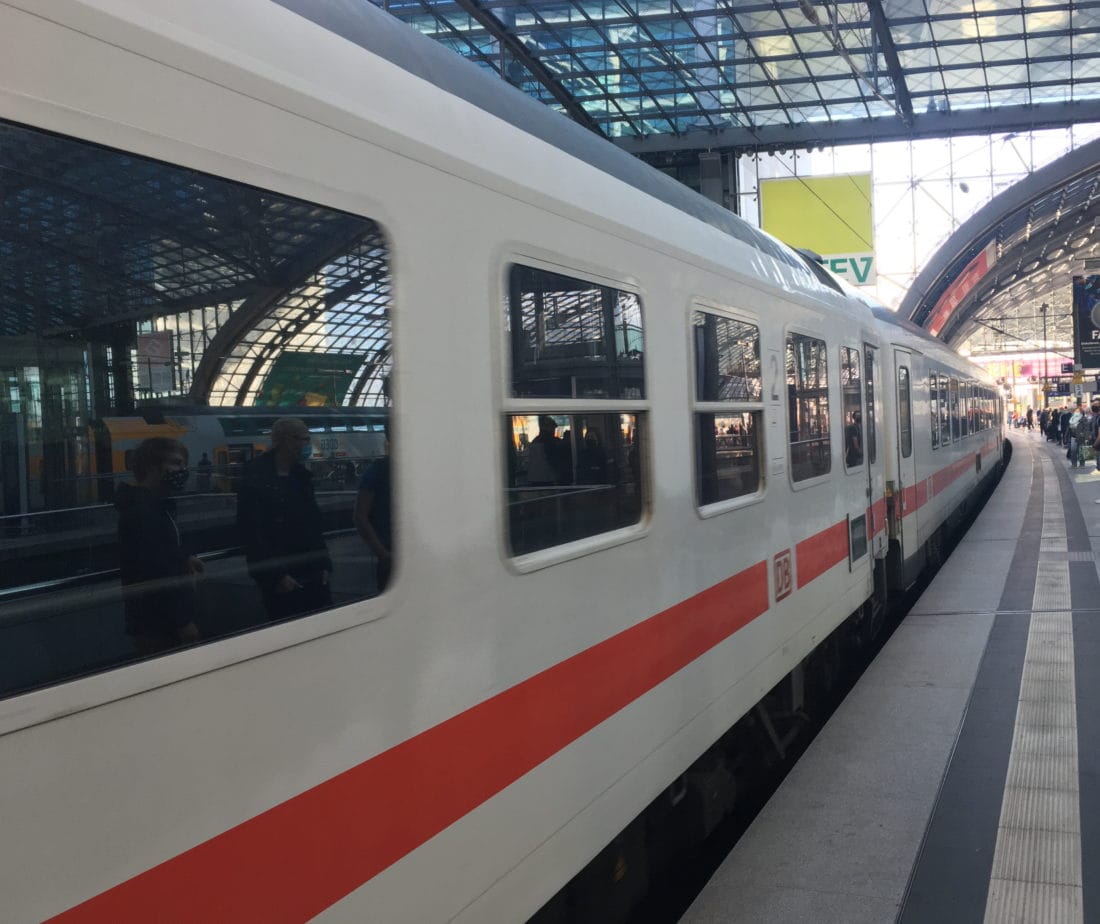
Regional Trains
A regional train gets you from Hamburg to Bremen as well, but stops at every shed in between. The seating is mostly fine.
In general, there are three types of regional trains, as well: Regionalexpress (RE), Regionalbahn (RB) and S-Bahn (S). While most RE trains stop far more often than long-distance trains, they are usually faster and stop less often than their regional train counterparts. RB trains stop everywhere while connecting two or three larger cities with all other stops in between. S-Bahn trains usually operate within larger urban areas and serve every minor station. These train types are cheaper than long-distance trains.
These trains are usually painted red with a white stripe.
FlixTrain
FlixTrain takes you from Hamburg to Bremen nonstop in a densely seated train. You probably pay less and get an assigned seat, but trains run much less frequently (about twice daily in contrast to DB’s hourly services).
FlixTrain is a private train company. It’s a subsidiary of Flixbus and offers selected connections on high-demand routes. They mostly operate trains with a dense seating pattern, so their comfort level is slightly worse. FlixTrain has its own pricing and ticket distribution system.
Unlike their intercity bus counterpart Flixbus, Flixtrain does not play a significant role in Germany’s public transportation network. Therefor, it’s not discussed further in the following sections. Unless it is specifically mentioned, none of the upcoming explanations applies to FlixTrain. DB tickets are not valid on FlixTrains and vice versa!
These trains are usually painted green.
Buying Tickets
There are plenty of ways to buy tickets – on the website, via the app, at a ticket machine, or even in a travel agency (remember those?). The most convenient and easy to navigate is their homepage. We will walk you through buying a ticket from Frankfurt to Munich, one of the busiest routes in Germany.
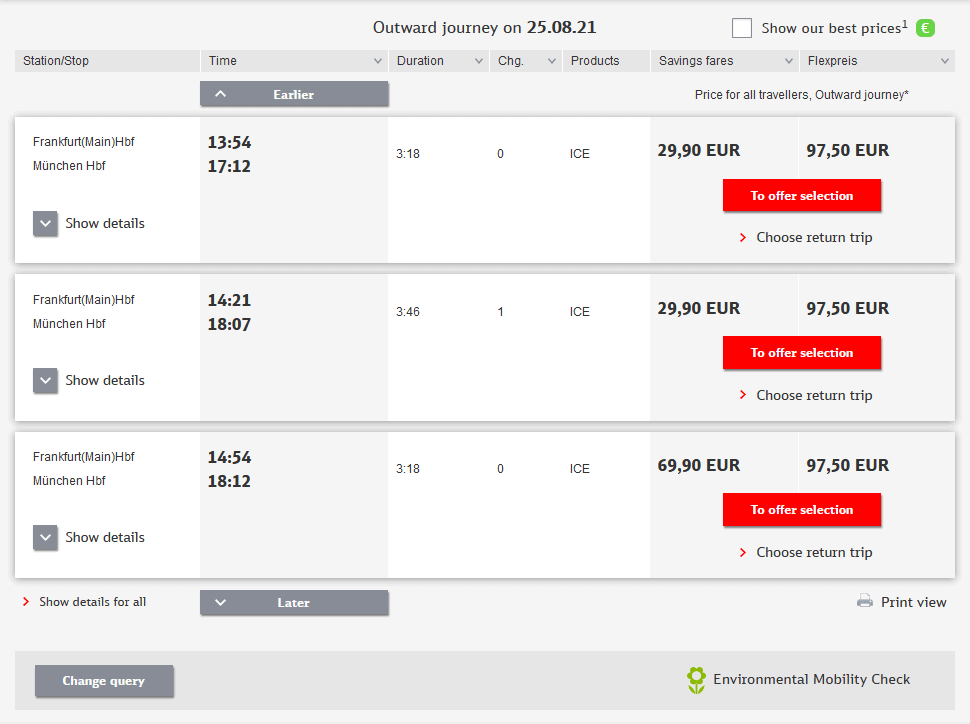
Out of the top three choices, you’d naturally select the first one if you don’t have any time restraints. Since the third option is the most expensive and the second one is about 30 minutes longer and includes a change of trains, the first one is the most appealing. By clicking offer selection, you will be hit by this:
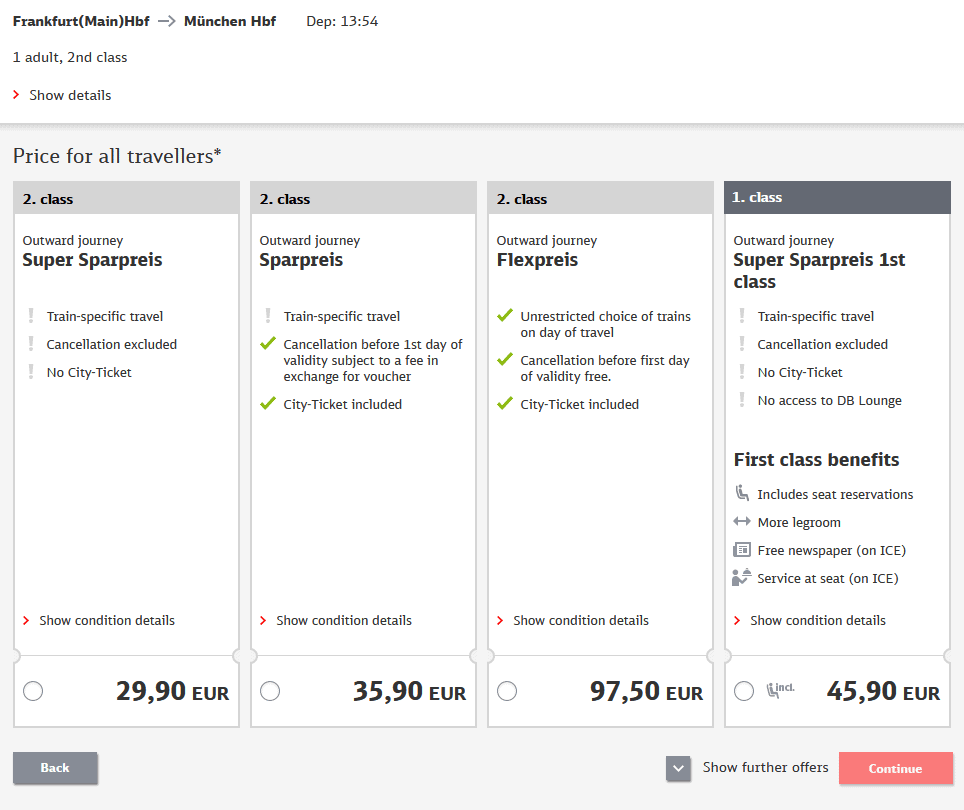
Since this might be a bit confusing for a first-time user, so we have a close look at each of the 4 second class offers…
Super Sparpreis / Super Saver Fare
Anyway, this is the cheapest, but also the most restrictive ticket you can buy. Especially on short-term bookings or busy travel days, it may already be sold out.
It is not refundable and restricted to a specific long-distance train on a specific date. You may not use other long-distance trains.
Even worse, it is valid on selected regional trains on your travel date.
We generally recommend buying this ticket, as it is the cheapest.
Sparpreis / Saver Fare
The Sparpreis is the second-cheapest variant. It comes with the same restrictions as the Super Sparpreis, with two differences.
Firstly, you may return this ticket in exchange for a voucher. But you will also have to pay a cancellation fee of €10.
Secondly, it includes a free City-Ticket, granting you a free ride in your arrival city with buses or subways. Usually, buying an extra ticket costs less than the difference between Sparpreis and Super Sparpreis.
Avoid the Sparpreis if you can. More often than not, the perks included are not worth the extra cost compared to the Super Sparpreis.
Flexpreis / Flex Fare
The Flexpreis is a more flexible and rather expensive ticket. It comes with the benefits of a refund in case you need to cancel.
In addition, you can choose any long-distance train in the right direction in addition to any regional train.
In our specific case, you could leave Frankfurt in the morning, stroll through Nuremberg in the afternoon and arrive in Munich in the evening.
A city ticket is also included in this package.
This ticket is usually so expensive, it doesn’t make sense to choose it without any BahnCard discounts.
Flexpreis Plus / Flex Fare Plus
The Flexpreis Plus represents the most expensive fare you can buy. In addition, to all benefits the Flexpreis offers, it is also valid for four days.
In our specific case, you could leave Frankfurt on Monday, stroll through Nuremberg on Wednesday and arrive in Munich on Thursday.
If you would rather go directly to your destination, you have the advantage of a seat reservation, as well. It is however limited to one specific train or connection. The Flexpreis Plus is the only second-class ticket to include a reservation.
The Flexpreis Plus represents the second-best value-for-money option. Especially in combination with a BahnCard, this ticket is a good choice.
Seat Reservations
In Germany, only first-class train tickets include a seat reservation. If you travel second class, you have to pay a fee of €4.50 for every seat you wish to reserve. Especially on busy days, you may end up standing in the aisle or sitting on the ground if you travel without a reservation. Also, large groups can end up separated easily.
Our general advice is to purchase a reservation on Fridays, Sundays, and Mondays. Whenever you buy a ticket, you will be asked specifically if you want to purchase a reservation. But you can also do this afterward. Select the option Seat only in the search mask and select the train you are bound to or plan to travel on.
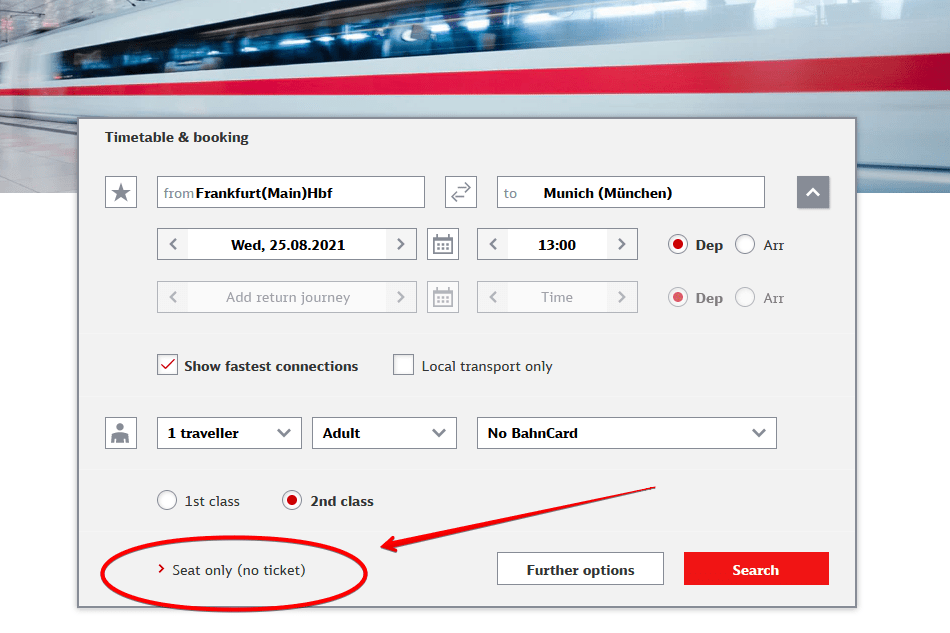
Search Directly for the Cheapest Ticket
If the travel or departure time is not a concern for you, you can search directly for the cheapest possible ticket by checking the show our best prices box on your search site:

It will show up after initiating a search between two cities. A user-friendly interface will guide to cheapest ticket available, sorted by departure times on your selected travel date.
First Class Prices & Services
Because the Deutsche Bahn likes money so much (don’t we all?), they are not hesitant to offer you first class prices along with your second class options.
First Class Prices
First Class prices offer the same options and restrictions as second class pricing (Super Sparpreis, Sparpreis, Flexpreis, Flexpreis Plus) with one important difference – a seat reservation is always included.
If you catch the train you originally booked, there is no chance you’ll end up sitting on the ground. The other important differences are the services, which are elaborated down below.
Sometimes, the first class Sparpreis is cheaper than the second class Sparpreis. In that case – go for it! If not, you’ll have to decide yourself if the services are worth the price difference.
First Class Services
In all German long-distance trains, first class seating comes with the following benefits:
- Included Reservations
- 2-1 seating instead of 2-2 seating in most second class cars.
- More legroom
On ICE trains:
- Food service at your seat (you still have to pay the food, just the service is free)
- Free Newspapers
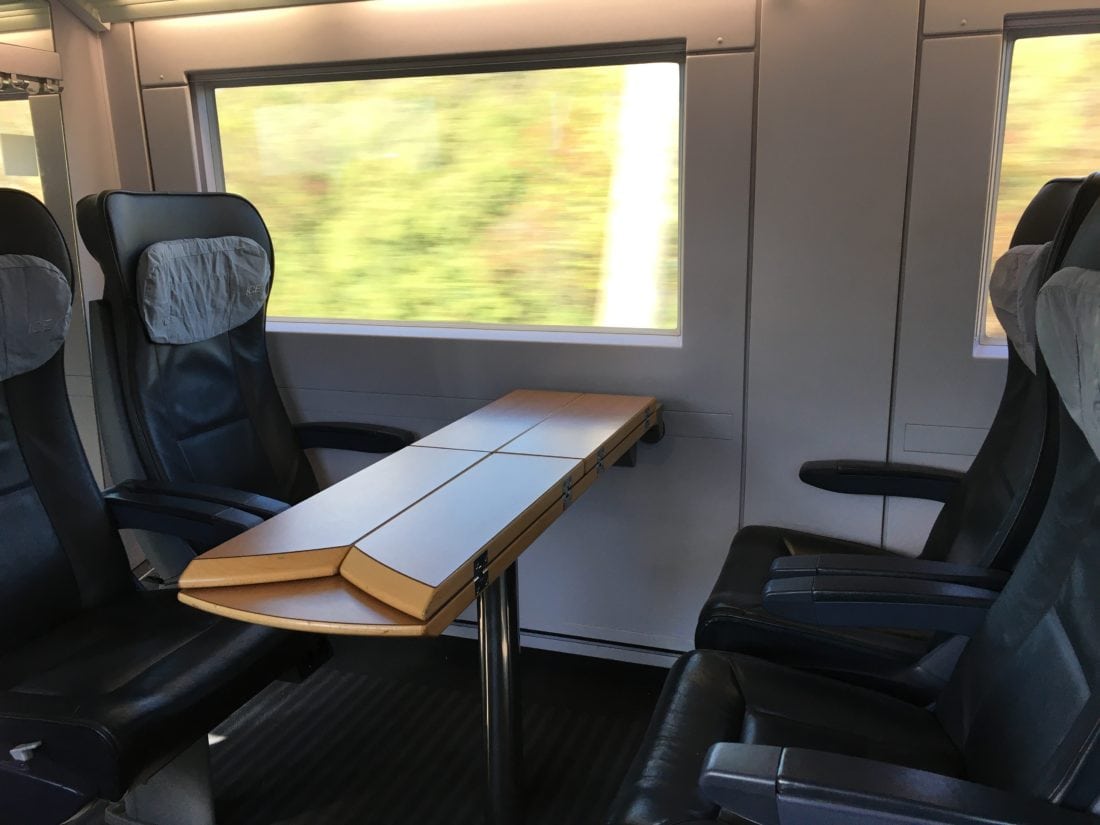
First class seating in an ICE. 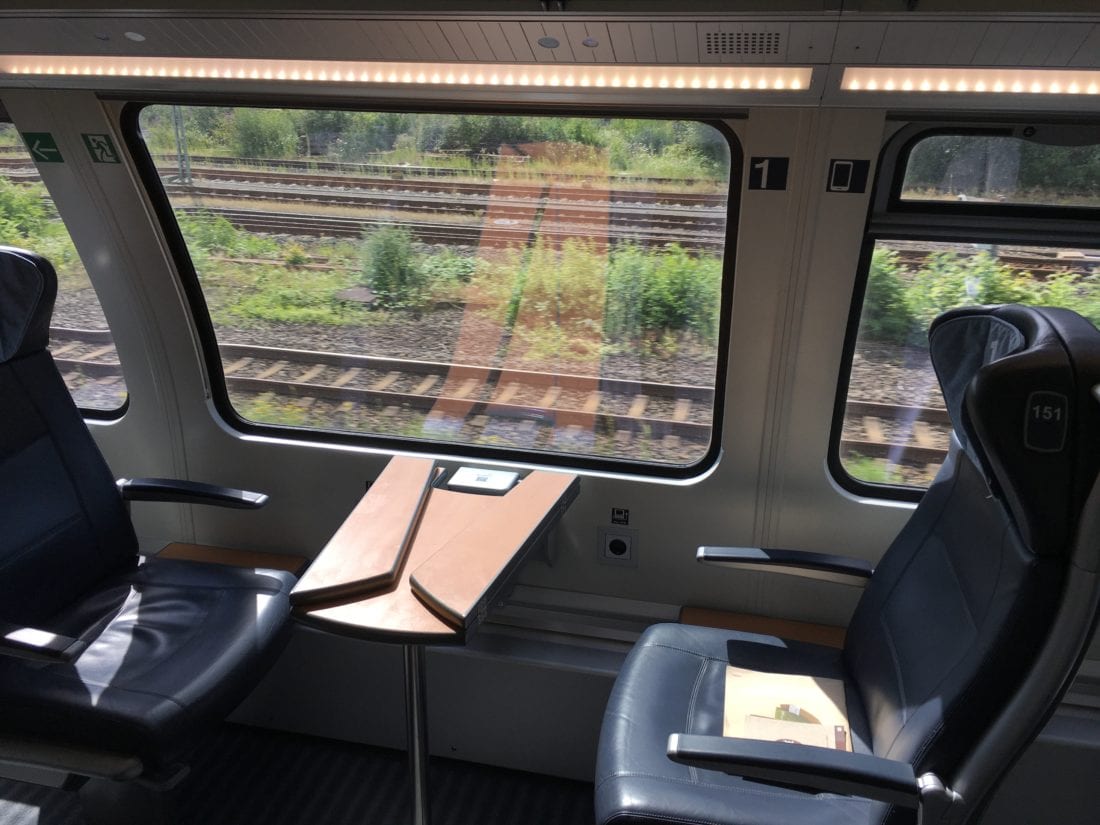
Single table seats are pretty nice for couples. 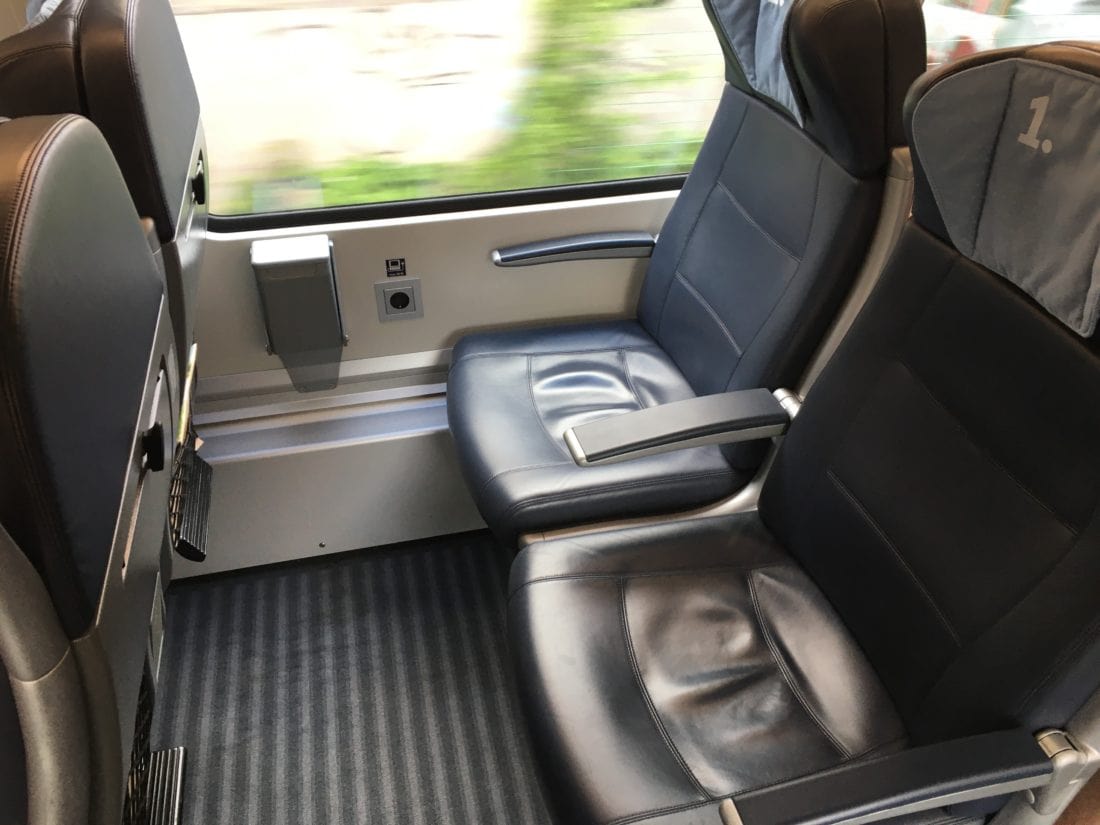
Great legroom in first class. 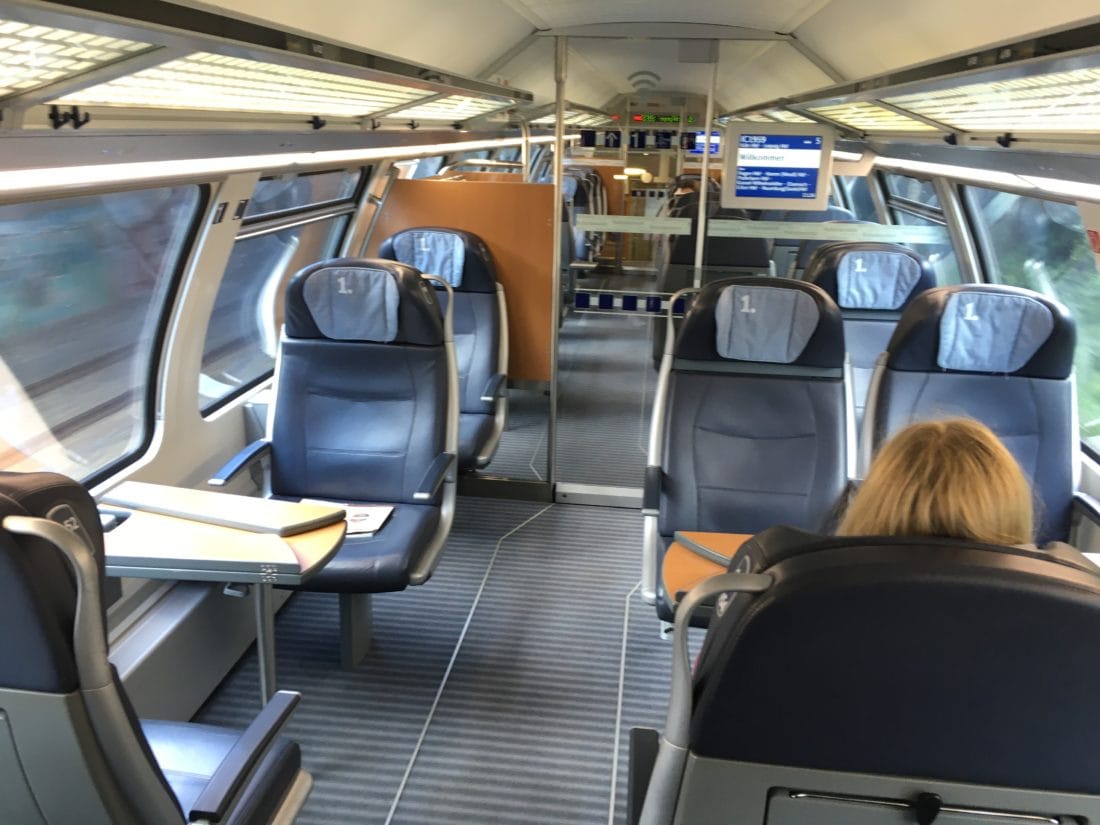
Typical 2-1 seating in first class.
Zugbindung
Fresh out of the popular series “Is there a German for it?”, we present: Is there a German word for buying a train ticket, but you can use it on only one specific train? Of course, there is, and that beautiful symphony of syllables is called Zugbindung.
As previously mentioned, all Sparpreis and Super Sparpreis tickets in all classes are only valid on one specific train (or several, if your itinerary contains one more connections). However, there is one way you can get rid of that restriction:
If one or more trains in your itinerary are delayed by more than 20 minutes, you are free to use whichever train you like.
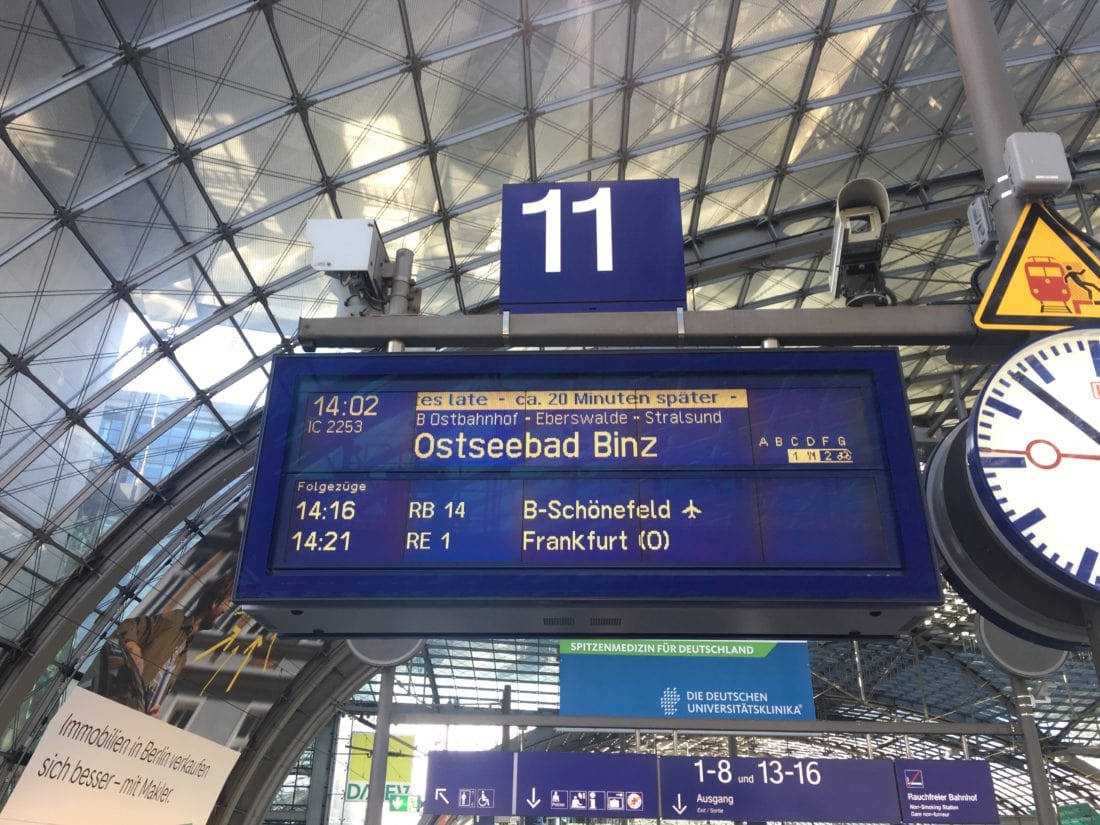
Seat reservations are bound to a specific train, as well. They are not changed if a delay causes you to miss your connection. In that case, you have to file a complaint to get a refund, if you did pay for a reservation.
The BahnCard – Your Way to a Discount
The BahnCard is a discount card for Deutsche Bahn, purchased at a fixed price and valid for a year after purchase. For example, these are the prices for the same train in the screenshot above, but with a BahnCard 50 discount applied:
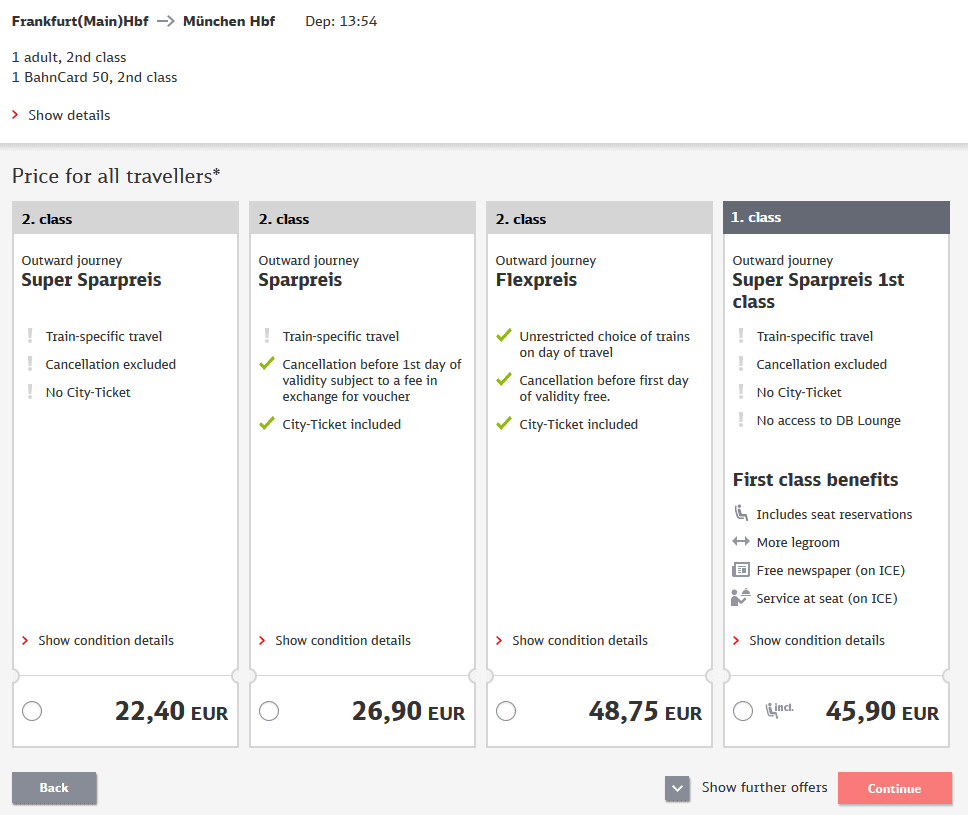
When the BahnCard was introduced in 1992, calculating the discounts was simple. There were three types of BahnCards, each valid for a year, that gave you a fixed discount on all tickets. The BahnCard 25 gave a 25% discount, the BahnCard 50 a 50%, and the BahnCard 100 let you use all trains, everywhere, for free.
It all started to change with the introduction of Sparpreis. There is no need to unwind this long and confusing chapter right now, so we introduce the three options straight away.
All Bahncards are subscriptions that renew automatically. You need to cancel them six weeks before their renewal, so you don’t get billed for the next year in advance. Use this form to cancel your Bahncard.
BahnCard 25
All Bahncard25 products give a 25% discount on both Sparpreis and Flexpreis. The following are second class prices, you can also order a specific Bahncard25 for first class tickets, which is more expensive. You can find more information here.
| Name | Sparpreis Discount | Flexpreis Discount | Validity | Age Restrictions | Price |
| BahnCard25 | 25% | 25% | 12 Months | None | €55.70 |
| Trial BahnCard25 | 25% | 25% | 3 Months1 | None | €17.90 |
| Youth BahnCard25 | 25% | 25% | 12 Months | 6-18 | €9.00 |
| My BahnCard25 | 25% | 25% | 12 Months | <26 Years2 | €34.90 |
| Senior BahnCard25 | 25% | 25% | 12 Months | >65 Years | €36.90 |
1The Trial Bahncard will turn into a regular Bahncard once the trial period is over. You need to cancel after six weeks or you will be billed €55.70 and receive a regular Bahncard after three months.
2The automatic renewal will automatically turn it into a regular bahncard once the holder becomes 27.
BahnCard 50
All Bahncard50 products give a 50% discount on Flexpreis and a 25% discount on Sparpreis. The following are second class prices, you can also order a specific Bahncard50 for first class tickets, which is more expensive. You can find more information here.
| Name | Sparpreis Discount | Flexpreis Discount | Validity | Age Restrictions | Price |
| BahnCard50 | 25% | 50% | 12 Months | None | €229.00 |
| Trial BahnCard50 | 25% | 50% | 3 Months1 | None | €71.90 |
| My BahnCard50 | 25% | 50% | 12 Months | <26 Years2 | €61.90 |
| Senior BahnCard50 | 25% | 50% | 12 Months | >65 Years | €114.00 |
1The Trial BahnCard will turn into a regular BahnCard once the trial period is over. You need to cancel after six weeks or you will be billed €229.00 and receive a regular BahnCard after three months.
2The automatic renewal will automatically turn it into a regular BahnCard once the holder becomes 27.
BahnCard100
The BahnCard 100 gives you access to every single train in Germany, but prices start at more than €1,000 even for the three-month trial version. Because of this, it is certainly not the choice for an occasional traveler, and we won’t go into further detail. You may find an overview on the Deutsche Bahn website here.
BahnCard Summary
For a foreign traveler visiting Germany for a couple of weeks, the Trial BahnCards are certainly worth a closer look, as you can easily save more money than you spend on them. However, this is only true if you don’t forget to cancel them, so the best way is to do it right after purchase. Otherwise, most BahnCards will only pay off if you spend at least 4-6 weeks each year in Germany and travel by train more than once a week.
The DB Navigator App
About the only thing that Deutsche Bahn gets unambiguous praise for is its app, which is super convenient and works absolutely flawlessly. You can get real-time schedule updates and save a digital version of your BahnCard. Even better, it eliminates the need for printed-out tickets, as you can save all your bookings in it. It also works pretty well for public transport on a city level and is a helpful tool in general when travelling in Germany.
Most members of the Travel-Dealz team purchase their tickets on the Bahn’s website and present them via the app, using their name and booking reference, as it is common with airline tickets these days. Even when traveling in neighboring countries like Austria, you can make good use of it, as its live schedule includes many other European railway companies.
Bottom Line
Even for Germans who travel by train regularly, the regulations and endless options of Deutsche Bahn’s ticketing system can be confusing. When you are travelling on a budget and look specifically for the cheapest ticket available, it can severely hamper your flexibility or comfort.
A key point and a massive double-edged sword is the lack of automatic seat assignments on German long distance trains. While it makes travelling with flexible tickets much easier, you can easily end up sitting on the floor for several hours in a train you may not leave if you are not willing to pay anything extra.
